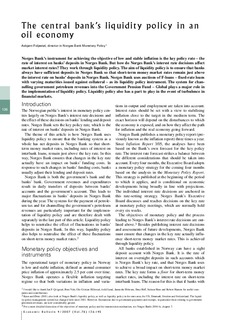The Central Bank’s Liquidity Policy in an Oil Economy
| dc.contributor.author | Fidjestøl, Asbjørn | |
| dc.date.accessioned | 2018-07-03T13:30:53Z | |
| dc.date.available | 2018-07-03T13:30:53Z | |
| dc.date.issued | 2007 | |
| dc.identifier.issn | 0029-1676 | |
| dc.identifier.issn | 1503-8831 | |
| dc.identifier.uri | http://hdl.handle.net/11250/2504200 | |
| dc.description.abstract | Norges Bank’s instrument for achieving the objective of low and stable inflation is the key policy rate – the rate of interest on banks’ deposits in Norges Bank. But how do Norges Bank’s interest rate decisions affect market interest rates? They work through liquidity policy. The aim of liquidity policy is to ensure that banks always have sufficient deposits in Norges Bank so that short-term money market rates remain just above the interest rate on banks’ deposits in Norges Bank. Norges Bank uses auctions of F-loans – fixed-rate loans with varying maturities issued against collateral – as its liquidity policy instrument. The system for channelling government petroleum revenues into the Government Pension Fund – Global plays a major role in the implementation of liquidity policy. Liquidity policy also has a part to play in the event of turbulence in financial markets. | nb_NO |
| dc.language.iso | eng | nb_NO |
| dc.publisher | Norges Bank | nb_NO |
| dc.rights | Attribution-NonCommercial-NoDerivatives 4.0 Internasjonal | * |
| dc.rights.uri | http://creativecommons.org/licenses/by-nc-nd/4.0/deed.no | * |
| dc.title | The Central Bank’s Liquidity Policy in an Oil Economy | nb_NO |
| dc.type | Journal article | nb_NO |
| dc.subject.nsi | VDP::Samfunnsvitenskap: 200::Økonomi: 210::Samfunnsøkonomi: 212 | nb_NO |
| dc.source.pagenumber | 136-145 | nb_NO |
| dc.source.journal | Economic Bulletin | nb_NO |
| dc.source.issue | 4/2007 | nb_NO |
Tilhørende fil(er)
Denne innførselen finnes i følgende samling(er)
-
Penger og Kreditt / Economic Bulletin [473]
1973 (1999)-2012

